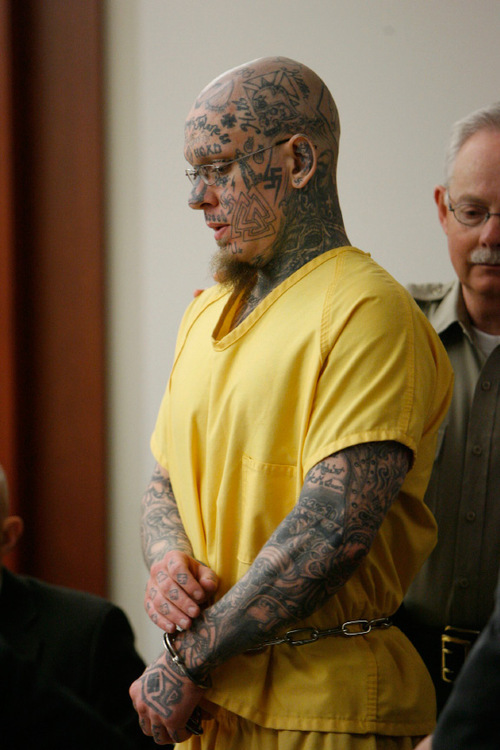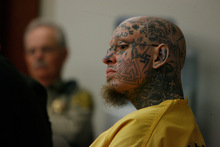This is an archived article that was published on sltrib.com in 2010, and information in the article may be outdated. It is provided only for personal research purposes and may not be reprinted.
Defense attorneys on Wednesday assured a 3rd District Court judge that a make-up artist will need just 10 minutes to cover Curtis Michael Allgier's numerous tattoos and make them invisible to jurors, not hours as the judge had envisioned.
The defense is afraid the murder suspect's head-to-toe tattoos — which include swastikas, neo-Nazi symbols and the words "Skin Head" written across his forehead — could negatively influence a jury.
Judge Paul Maughan will not decide until later this month whether to allow Allgier to cover up during the first part of his trial, where the jury will decide whether he is guilty.
But Maughan told the defense Wednesday that if Allgier is found guilty of killing 60-year-old Corrections Officer Stephen Anderson, he will not allow the use of make-up during the second part of the trial — the penalty phase where the jury will decide whether to impose the death penalty.
At that point in the trial, Maughan said, "the state has a right to show Mr. Allgier as Mr. Allgier."
The judge's pronouncement seemed to cause the defense to reconsider the wisdom of hiding Allgier's prison ink.
Said defense attorney Ralph Dellapiana: "If the jury is going to be surprised [by Allgier's tattoos] halfway through, then maybe it's not an effective strategy to cover them up at all."
The Salt Lake County District Attorney's Office has filed a motion opposing the use of make-up, claiming the tattoos are relevant for purposes of identifying Allgier.
Utah court rules say a defendant should appear in court appearing approximately as he did at the time of the alleged crime, according to prosecutors. They also argued other courts have found visible tattoos were not necessarily prejudicial to a defendant.
Prosecutor Robert Stott called the idea of using a make-up artist to hide tattoos was "a first ... it's unique."
Allgier, 31, is charged with capital murder for allegedly killing Anderson with his own gun after Anderson unshackled him for an MRI scan June 25, 2007, at a Salt Lake City medical clinic.
Attorneys told Maughan three months ago they expect to be able to try the case in the spring of 2011. But new issues keep cropping up.
Dellapiana said his team expects to file another 40 motions, including a motion asking the judge to stop Salt Lake County jail personnel from interfering with Allgier's attorney/client privilege.
Dellapiana said jailers have been "surveilling" their meetings with Allgier, and reading Allgier's mail dealing with legal issues.
The defense also wants the jail to provide 726 videos of Allgier being taken from his cell each day.
Dellapiana said the tapes deal with the question of whether Allgier can be managed in a correctional setting, and may be crucial to the jury's deliberation on whether to impose the death penalty.
"His life may depend upon it," said Dellapiana, adding Allgier is "a model inmate and can be safely managed in an institutional setting."
Meanwhile, the Utah Supreme Court is deciding whether a letter written by a former Utah State Prison inmate that contains information about Allgier can be unsealed and released to the public. The defense has expressed concern that publicity about the letter's contents, penned by Brent Mayon Cobb, would jeopardize Allgier's right to a fair trial.
Following a three-day preliminary hearing in March, Allgier was bound over on one count of capital murder, as well as charges of seven other felonies connected to Allgier's short-lived escape, which ended when a citizen disarmed him during a struggle inside an Arby's restaurant.





